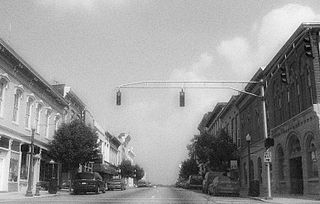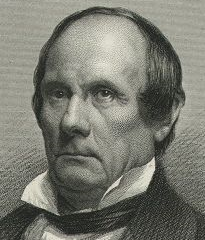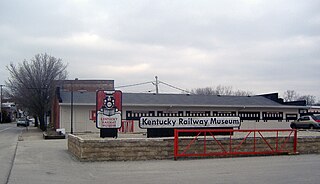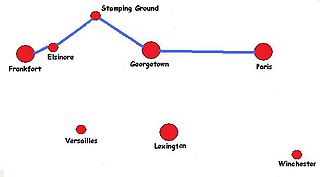
Cloverport is a home rule-class city in Breckinridge County, Kentucky, United States, on the banks of the Ohio River. The population was 1,152 at the 2010 census.

Stanford is a home rule-class city in Lincoln County, Kentucky, United States. It is one of the oldest settlements in Kentucky, having been founded in 1775. Its population was 3,487 at the 2010 census and an estimated 3,686 in 2018. It is the county seat of Lincoln County. Stanford is part of the Danville Micropolitan Statistical Area.

Shelbyville is a home rule-class city in and the county seat of Shelby County, Kentucky, United States. The population was 17,282 at the 2020 census.

James Guthrie was an American lawyer, plantation owner, railroad president and Democratic Party politician in Kentucky. He served as the 21st United States Secretary of the Treasury under Presidents Franklin Pierce and James Buchanan, and then became president of the Louisville and Nashville Railroad. After serving, part-time, in both houses of the Kentucky legislature as well as Louisville's City Council before the American Civil War, Guthrie became one of Kentucky's United States senators in 1865. Guthrie strongly opposed proposals for Kentucky to secede from the United States and attended the Peace Conference of 1861. Although he sided with the Union during the Civil War, he declined President Abraham Lincoln's offer to become the Secretary of War. As one of Kentucky's senators after the war, Guthrie supported President Andrew Johnson and opposed Congressional Reconstruction.

The Louisville and Nashville Railroad, commonly called the L&N, was a Class I railroad that operated freight and passenger services in the southeast United States.

The Union Station of Louisville, Kentucky is a historic railroad station that serves as offices for the Transit Authority of River City (TARC), as it has since mid-April 1980 after receiving a year-long restoration costing approximately $2 million. It was one of at least five union stations in Kentucky, amongst others located in Lexington, Covington, Paducah and Owensboro. It was one of three stations serving Louisville, the others being Central Station and Southern Railway Station. It superseded previous, smaller, railroad depots located in Louisville, most notably one located at Tenth and Maple in 1868–1869, and another L&N station built in 1858. The station was formally opened on September 7, 1891, by the Louisville and Nashville Railroad. There was a claim made at the time that it was the largest railroad station in the Southern United States, covering forty acres. The other major station in Louisville was Central Station, serving the Baltimore and Ohio, the Illinois Central and other railroads.

The Kentucky Railway Museum, now located in New Haven, Kentucky, United States, is a non-profit railroad museum dedicated to educating the public regarding the history and heritage of Kentucky's railroads and the people who built them. Originally created in 1954 in Louisville, Kentucky, the museum is at its third location, in extreme southern Nelson County. It is one of the oldest railroad stations in the United States.

John LaRue Helm was the 18th and 24th governor of the U.S. Commonwealth of Kentucky, although his service in that office totaled less than fourteen months. He also represented Hardin County in both houses of the Kentucky General Assembly and was chosen to be the Speaker of the Kentucky House of Representatives four times. In 1838, his sole bid for federal office ended in defeat when his opponent, Willis Green, was elected to the U.S. House of Representatives.

U.S. Route 31E (US 31E) is the eastern parallel route for U.S. Highway 31 from Nashville, Tennessee, to Louisville, Kentucky.
The Louisville and Nashville Depot, or Louisville and Nashville Railroad Depot or Louisville and Nashville Passenger Station, Louisville and Nashville Railroad Passenger Depot or variations, may refer to the following former and active train stations previously used by the Louisville and Nashville Railroad. Some of these are listed on the National Register of Historic Places (NRHP).
Jeptha Barnard Bright Jr, better known as Barney Bright, born in Shelby County, Kentucky and was a sculptor from Louisville, Kentucky, is best known for his work on the Louisville Clock.

The Historic Railpark and Train Museum, formerly the Louisville and Nashville Railroad Station in Bowling Green, Kentucky, is located in the historic railroad station. The building was placed on the National Register of Historic Places on December 18, 1979. Opened in 1925, the standing depot is the third Louisville & Nashville Railroad depot that served Bowling Green.

The L & N Railroad Depot in the Hopkinsville Commercial Historic District of Hopkinsville, Kentucky is a historic railroad station on the National Register of Historic Places. It was built by the Louisville & Nashville Railroad in 1892.

Wickland is a historic mansion in eastern Bardstown, Kentucky. It has been the home of three state governors: two for Kentucky, and one in Louisiana.

The Bardstown station, also known as Old L & N Station, is a historic railroad station on the National Register of Historic Places in the northernmost section of the Bardstown Historic District of Bardstown, Kentucky. Long owned by the Louisville and Nashville Railroad (L&N), it is currently used as the station for the My Old Kentucky Dinner Train, owned by the R.J. Corman Railroad Group.

Louisville & Nashville 152 is a preserved K-2a class 4-6-2 "Pacific" type steam locomotive listed on the National Register of Historic Places, currently homed at the Kentucky Railway Museum at New Haven, Kentucky in southernmost Nelson County, Kentucky. It is the oldest known remaining 4-6-2 "Pacific" type locomotive to exist. It is also the "Official State Locomotive of Kentucky", designated as such on March 6, 2000. The locomotive is currently owned and being restored back to operating condition by the Kentucky Railway Museum.

The Louisville and Nashville Combine Car Number 665, also known as the "Jim Crow Car", is a historic railcar on the National Register of Historic Places, currently at the Kentucky Railway Museum at New Haven, Kentucky, in southernmost Nelson County, Kentucky.

The Frankfort and Cincinnati Railroad is a defunct shortline railroad based in Kentucky. Despite its name, it had no connections with Cincinnati, Ohio.
The PD Subdivision is a railroad line owned by CSX Transportation in Florida and Alabama. The line runs from Pensacola, Florida, north to Flomaton, Alabama, for a total of 41.0 miles (66.0 km). At its south end it connects to the Florida Gulf & Atlantic Railroad and at its north end it continues north as the M&M Subdivision.

Julia A. Tevis was a pioneer educator of women from Kentucky. After teaching for several years in Virginia, she founded the Science Hill Female Academy in Shelbyville and led the institution to gain a national reputation for excellence. Teaching her students math and science, rather than how to be accomplished seamstresses, Tevis prepared young women for colleges.




















